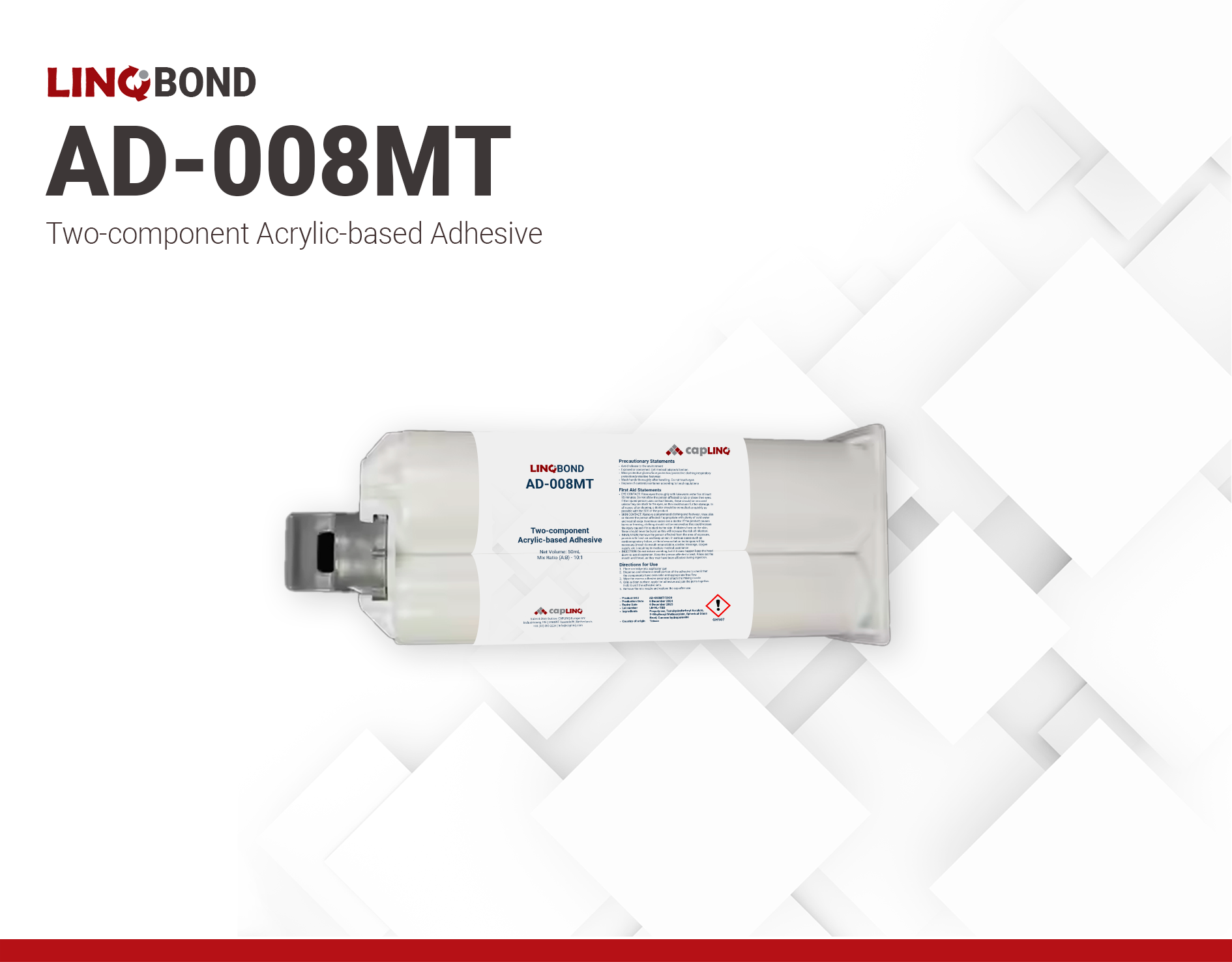LINQBOND AD-008MT | Two-component Acrylic-based Adhesive
Harmonization Code : 3907.30.00.90 | Polyacetals, other polyethers and epoxide resins, in primary forms; polycarbonates, alkyd resins, polyallyl esters and other polyesters, in primary forms : Epoxide resins : Other
Main features
- No surface treatment required
- Excellent chemical resistance
- Zero solvent formulation
Product Description
LINQBOND AD-008MT is a two-component acrylic-based adhesive that does not require treatment. AD-008MT displays excellent adhesion on materials with low surface energy post-curing. This includes polypropylene (PP), polyethylene (PE), thermoplastic opolyolefin (TPO), and metal.
LINQBOND AD-008MT can function as replacements for screws, rivets, plastic welding, and two-step processes, including of chemical etchants, primers, or surface treatments in a wide selection of applications.
Key Features:
- Good handling property after mixing.
- Zero solvent formula and environmentally-friendly
- Excellent chemical and water resistance
Applications
- Bonding of PP, PE, TPO, and metal components
- Replacement for screws, rivets, plastic welding, and two-step adhesive processes
- Structural assemblies requiring water and chemical resistance
- General industrial, automotive, and plastic fabrication applications
Technical Specifications
| General Properties | |||||||
| Mix Ratio Mix Ratio The amount of a constituent divided by the total amount of all other constituents in a mixture | 10A:1B | ||||||
| Specific Gravity Specific Gravity Specific gravity (SG) is the ratio of the density of a substance to the density of a reference substance; equivalently, it is the ratio of the mass of a substance to the mass of a reference substance for the same given volume. For liquids, the reference substance is almost always water (1), while for gases, it is air (1.18) at room temperature. Specific gravity is unitless. | 1.08A; 1.03–1.12B | ||||||
| |||||||
| Electrical Properties | |||||||
| Surface Resistivity | 4300000000000 Ohms/sq | ||||||
| Volume Resistivity Volume Resistivity Volume resistivity, also called volume resistance, bulk resistance or bulk resistivity is a thickness dependent measurement of the resistivity of a material perpendicular to the plane of the surface. | 4.4x1013 Ohms⋅cm | ||||||
| Other Properties | |||||||
| RoHS Compliant RoHS Compliant RoHS is a product level compliance based on a European Union Directive which restricts the Use of certain Hazardous Substances in Electrical and Electronic Equipment (RoHS). Products compliant with this directive do not exceed the allowable amounts of the following restricted materials: lead, mercury, cadmium, hexavalent chromium, polybrominated biphenyls (PBB) and polybrominated diphenyl ethers (PBDE), with some limited exemptions | Yes | ||||||
| Mechanical Properties | |||||||
| |||||||
| |||||||
| Curing Conditions | |||||||
| |||||||
| Thermal Properties | |||||||
| Degradation temperature Degradation temperature The temperature at which the materials start losing their properties | 240 °C | ||||||
| Glass Transition Temperature (Tg) Glass Transition Temperature (Tg) The glass transition temperature for organic adhesives is a temperature region where the polymers change from glassy and brittle to soft and rubbery. Increasing the temperature further continues the softening process as the viscosity drops too. Temperatures between the glass transition temperature and below the decomposition point of the adhesive are the best region for bonding. The glass-transition temperature Tg of a material characterizes the range of temperatures over which this glass transition occurs. | 30 °C | ||||||
| Thermal Conductivity Thermal Conductivity Thermal conductivity describes the ability of a material to conduct heat. It is required by power packages in order to dissipate heat and maintain stable electrical performance. Thermal conductivity units are [W/(m K)] in the SI system and [Btu/(hr ft °F)] in the Imperial system. | 0.26 W/m.K | ||||||
| Weight Loss @ 300°C | 8.9 % | ||||||
| |||||||
Additional Information
Typical Curing Properties
| Property | Magnitude | Units |
| Mix rate (A:B) | 10:1 | by weight or volume |
| Work Life (25 °C, 0.5 g) | 7 | mins |
| Partially Cure Time @25-33℃ | 2-4 | hrs |
| Full Cure Time @25-33℃ | 18-36 | hrs |
Directions for Use
- When using this product, discard the front end of Part A and Part B. Mix the two parts and coat the product onto the substrate for maximum bonding performance.
- The adhesive should be applied on a clean surface free of dirt, grease, or mold release. In the case that it is coated with such, a simple solvent wipe will suffice.
- Mix thoroughly by volume (10:1 mix ratio) before use.
- After mixing the two parts, the adhesive should be used within its pot life.
- For maximum bonding strength, apply the adhesive evenly to both surfaces that will be joined together.
- For handling information, refer to the attached Technical Data Sheet.
Cartridge Nozzle and Cap Installation Guide



